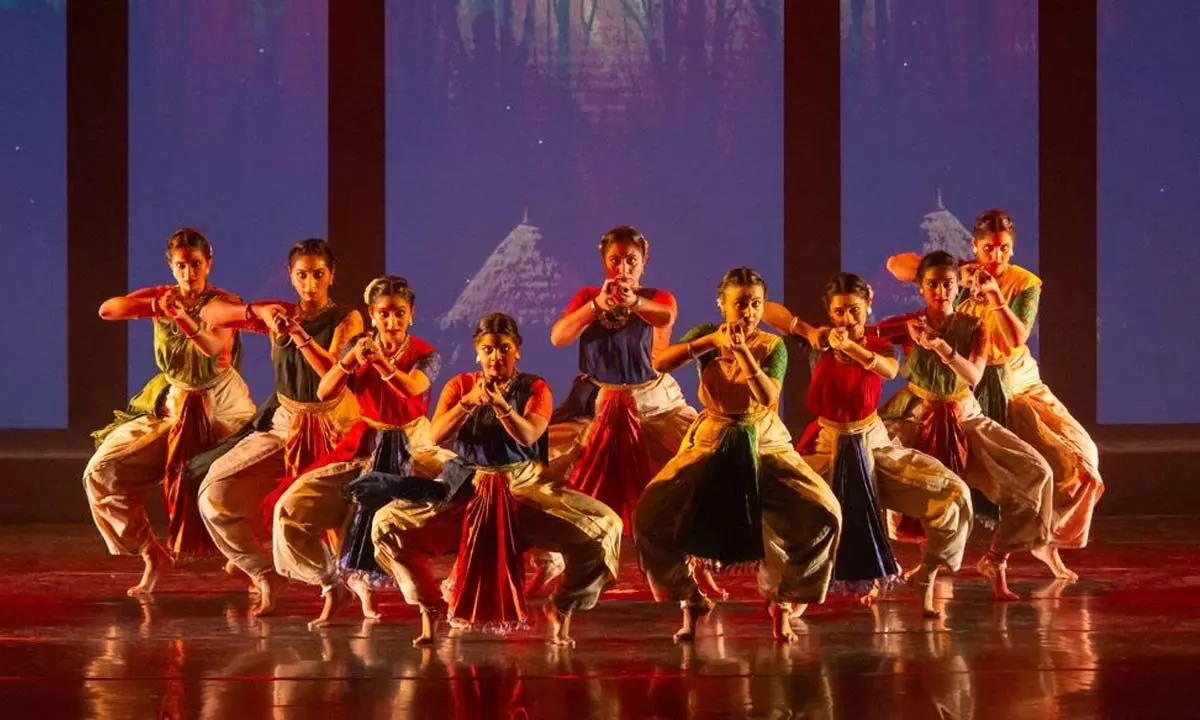Live
- Experience the Best Human Hair Extensions with Gemeria
- Advanced F&O strategies for experienced investors - Straddles, strangles, Iron condors
- Dr. Harikiran Chekuri suggests that a hair transplant can help regain hair growth to reclaim confidence and self-esteem
- Chandrababu Praises Mahayuti Alliance for Maharashtra Assembly Elections win
- Where Drops Define Destiny: The Elite Chronicles of IPC's 30th Revolution
- Aahwahan Foundation Launches “Sapnon Ke Sawari” Initiative to Empower Differently-Abled Individuals
- Are Market-linked Plans Suitable for First-time Investors?
- Vijay to host farmers, landowners who provided venue for TVK’s first meet in TN
- Bengal bypolls: Trinamool candidates declared elected from Naihati, Sitai; leading in other four seats too
- Black Friday 2024: Amazon, Samsung, Sony Discounts Unveiled; More Brands To Join
Just In
A Mesmerising TributeA Mesmerising Tribute


Recently, Ravindra Bharathi witnessed a spectacular Classical Dance Theatre Production premiere by Shankarananda Kalakshetra titled “Manyam Veerudu - Alluri Sitaramaraju.”
Recently, Ravindra Bharathi witnessed a spectacular Classical Dance Theatre Production premiere by Shankarananda Kalakshetra titled “Manyam Veerudu - Alluri Sitaramaraju.” The grandeur of sizzling choreography, outstanding vocals by Swetha and Renuka Prasad, spectacular lighting by Surya Rau, and Gunjan Ashtaputre’s special scene-shifting screen effects combined with exquisite costumes and jewellery was put together by the renowned Bharatanatyam Guru Padmashri Dr Ananda Shankar Jayant. Her forte is the faultless planning of such masterpieces.
The story of Ramaraju is a short one - valorous yes - but also sad and melancholic. He died at 26 years old, and his struggle and rebellion lasted for about two years. Yet, the choreography envisioned this as an uplifting, navarasa-laden production from the start. A brisk thillana in Mohanam established the content and happy state of the tribals in the Eastern Ghats, with a quick cameo depiction of Podu cultivation captured in the movements and folk-like steps. The Goddesses Pochamma and Maisamma are prayed to as the deities of the tribals.
The story then shifts mood to the arrival of the British on the scene, with a Kuchipudi team of dancers in uniform-like attire led by a menacing Surendranath. Their harsh methods deprived the tribals of their homeland and sustenance following the promulgation of the Forest Act of 1882. At this point, the stunning entry of the hero Ramaraju, who chases the British away to the sound of a jathi that has the Telugu word “Tarimi” (to chase away) embedded into the choreography, was a masterstroke of creative thinking. It was a grand patra pravesham indeed by Mithun Shyam in saffron robes as Ramaraju, matching the role perfectly! His athletic moves of fluid grace and gymnastic leaps thrilled the audience.
The shift from despondency to being inspired is smoothly established in a simple poem, “Idi Ma Manyam.” How the simple tribals were trained to become tough warriors was an outstanding piece of dance - in a short and simple swara in Rasikapriya. Yoga and Kalari movements, archery, swordplay, and learning horse riding evoked the martial readiness and zeal of the group with one purpose - Do or Die! Ananda’s team scored with perfect synchrony in both symmetrical as well as asymmetric dance design, giving the spectators a bird’s eye view of what goes into the making of a warrior.
A brief interlude showcased the love that blossomed between Sita and Ramaraju, which was poetry in movement. Neha Sathanapalli was a blithe Sita who charmed in the playful duet scene in Brindavana Saranga, evoking shringara rasa. Though she is lost to Ramaraju, her name joined to his became immortal. The beginning of the revolt against the colonial forces is marked by a stealth attack set to Mishra Alarippu. This was exceptional and struck a chord immediately by the scene capture.
The Manyam rebellion, which was done only by the use of rudimentary and makeshift weapons at first, is defeated by guns (a sudden gunshot sound onstage was stunning!) as portrayed in surpassing scenes of injury and vanquishment through theatrical abhinaya. Ramaraju once again inspires the arisal from the ashes of defeat and despondence. Dejection gives way to enthusiasm as Ramaraju infuses bravery. Understanding the need to have guns of their own, they find multifarious ways to steal them from the British.
Ananda again brought her deft touch to devise comically tinged dance in Kuntalavarali dramatically to depict this, bringing a lighter touch to the somber mood. The audience was caught by surprise as they encountered an unusual scene of six alluring girls striding across the stage twirling ribbons in myriad patterns to confuse and lure away the British, who leave their guns behind. Scenes of scaring the Britishers with the sounds of wild animals or adding something to their food to bewilder them were evocative. The stealthy, sly, and slippery movements denoting the silent sneaking away needed to pilfer the guns from the police stations were again a masterclass in choreography of a high order.
The final denouement with fight sequences involving various weapons was riveting and had the audience on the edge of their seats as the energy levels of the dancers and their movements gave a cinemacopic view of the actual war, where in the end Ramaraju is killed, outnumbered by overwhelming forces. The production does not end in death but goes on to say - “They Said They Killed Ramaraju! - Did They?” An inspired concluding voice-over from Jayant Dwarkanath for this bilingual production explained that from where Ramaraju rises again, his spirit will inspire others as Sitaramaraju becomes larger than life and a legend all over India. In less than a quarter-century later, the Tricolour rose was the message conveyed as the silhouetted portrait of Sitaramaraju was projected on screen, moving the audience to a standing ovation!

© 2024 Hyderabad Media House Limited/The Hans India. All rights reserved. Powered by hocalwire.com






